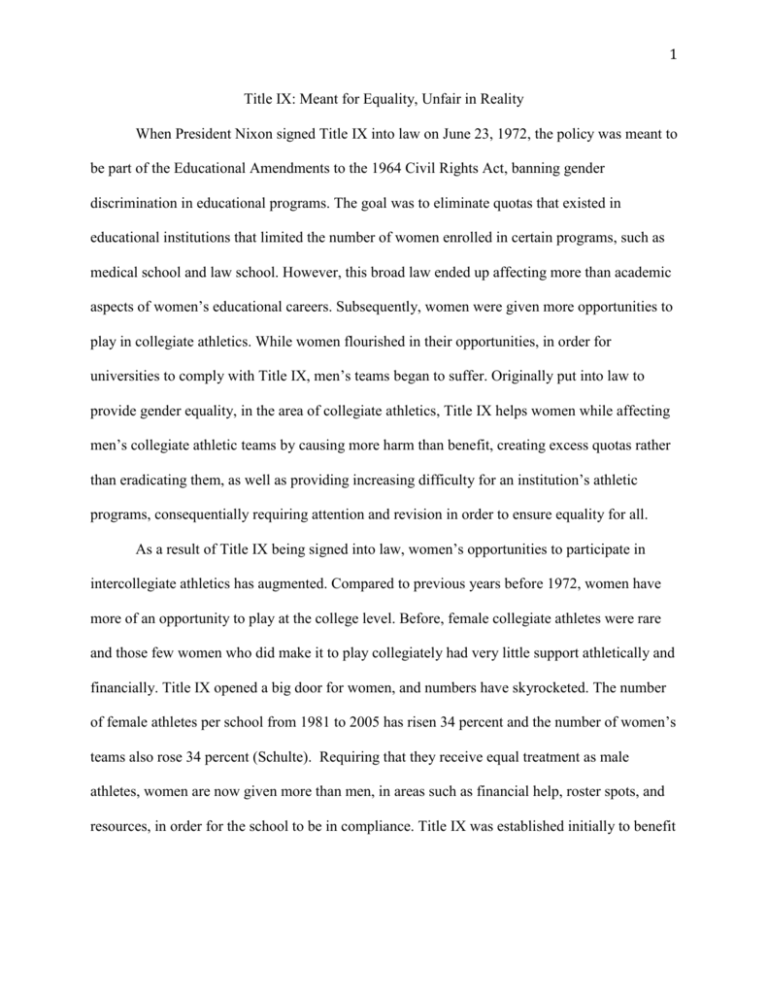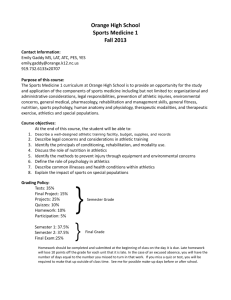ENG 100 Research Paper- Contest
advertisement

1 Title IX: Meant for Equality, Unfair in Reality When President Nixon signed Title IX into law on June 23, 1972, the policy was meant to be part of the Educational Amendments to the 1964 Civil Rights Act, banning gender discrimination in educational programs. The goal was to eliminate quotas that existed in educational institutions that limited the number of women enrolled in certain programs, such as medical school and law school. However, this broad law ended up affecting more than academic aspects of women’s educational careers. Subsequently, women were given more opportunities to play in collegiate athletics. While women flourished in their opportunities, in order for universities to comply with Title IX, men’s teams began to suffer. Originally put into law to provide gender equality, in the area of collegiate athletics, Title IX helps women while affecting men’s collegiate athletic teams by causing more harm than benefit, creating excess quotas rather than eradicating them, as well as providing increasing difficulty for an institution’s athletic programs, consequentially requiring attention and revision in order to ensure equality for all. As a result of Title IX being signed into law, women’s opportunities to participate in intercollegiate athletics has augmented. Compared to previous years before 1972, women have more of an opportunity to play at the college level. Before, female collegiate athletes were rare and those few women who did make it to play collegiately had very little support athletically and financially. Title IX opened a big door for women, and numbers have skyrocketed. The number of female athletes per school from 1981 to 2005 has risen 34 percent and the number of women’s teams also rose 34 percent (Schulte). Requiring that they receive equal treatment as male athletes, women are now given more than men, in areas such as financial help, roster spots, and resources, in order for the school to be in compliance. Title IX was established initially to benefit 2 women by requiring everything to be equal, however though the process, focus was placed more on women then men, resulting in women receiving much more than men. While Title IX has brought about and enforced gender equality and improved treatment for women, school’s accommodate the law by neglecting non-revenue men’s sports and placing them in jeopardy of losing funds or being cut completely. Statistics across the board show that men’s teams have suffered as a result of school’s actions responding to Title IX, and the number of male athletes and teams has been cutback. As the effects of the new policy started hitting athletic programs, male athletes per school declined 6 percent while schools also saw a decrease of men’s teams by 17 percent (Schulte). Troy Dannen, athletic director at Northern Iowa, discusses the approach to the school’s athletic gender ratio saying, “We weren’t going to look at a women’s program, we had to look at the men’s side of it” (Watson). When deciding what sports to cut or decrease, non-revenue sports were the first to go. As stated in John Pearson and Heather Newton’s research, “Between 1972 and 2001, according to General Accounting Office figures, schools cut almost 200 men’s wrestling programs along with at least 80 men’s tennis teams, 70 men’s gymnastics teams, and 45 men’s track teams.” While men are shown to have a higher interest to continue playing sports in college, the lack of teams in non-revenue sports leaves some men without the opportunity to progress in their athletic career. In order to accommodate the fewer amount of females that are interested and qualified to play sports in college, schools are forced to cut the number of male athletes. Appalachian State Assistant Track Coach, April Smith, talks about how Title IX affects the Appalachian State Track Team, explaining that previously the team was required to have forty-eight girls and fortyfive guys, but as a result of Title IX and compensating the women’s team to equalize football, the team may now have sixty-five women, while cutting their men’s team to thirty-five men. 3 Smith goes on to say that with sixty-five women, only twenty-five are able to go to conference, so there are over forty women who are on the team and know they cannot compete at the conference level (Smith). Even though the number of girls that desire to continue their athletic career in college may be growing, many are not at the level to compete collegiately. Colleges result to shelling out money for girls who do not fit school standards in order to reach the quota set by Title IX, while the money could be equally shared with men that reach the athletic standards. Along with cutting teams, the amount of scholarships available for men’s programs has decreased significantly. Equal money has to be given to both men and women in a school’s athletic program and in order to counteract the money spent for football athletes, less money is available for the remaining male athletes. Equal money would be a benefit of Title IX, however because football takes up most of men’s scholarships and there are no women’s teams to compensate for football, other men’s teams get cut on scholarships. All other sports have a female and male equivalent: men’s and women’s track, men’s and women’s soccer, baseball and softball. Volleyball and football are meant to counteract each other, but a football team is much larger than a women’s volleyball team. Smith says: Football is its own beast… there is no sport that can equalize it…We [Appalachian State University Track Team] have eighteen scholarships on the women’s side and only twelve on the men’s, and that is fully-funded, in-state wise. Well, that is because football has eighty to eighty-five scholarships. There is no way to compensate. It is not because they are taking money away from the men’s side and giving it to the women, it is because they have to compensate for football. 4 Even though Title IX was put into policy to fix the football “beast”, Title IX is actually skewed as a result of the main revenue sport, which therefore impacts the scholarships and money available for male athletes. If football was taken out, women’s volleyball and men’s wrestling would compensate for each other and men’s programs would not lose money or teams. Including scholarship money, Title IX has imposed more quotas rather than getting rid of them. According to Christina Sommers, writer for Time Magazine, “The original law was about equality of opportunity and indeed forbade quotas or reverse discrimination schemes” (Sommers). As a result of Title IX, in order to be in compliance, a school’s percentage of women’s athletes must match the percentage of women enrolled at the institution (Farmer). While trying to eliminate quotas not allowing women into educational programs, Title IX establishes more quotas requiring a certain percentage of girls to play college sports. This is especially hard for schools that have high percentages of women enrolled. These schools result to looking at decreasing their men’s programs to have the right men-to-women ratio. The proportionality gap, the difference between the number of women enrolled in a university and the number of women playing athletics in that institution multiplied by 100, is another aspect used to evaluate whether a school is in compliance with Title IX (Anderson 307). In a study observing the changes between number of teams and players from the 1995/1996 to the 2001/2002 school years, the results showed that, “Division 1 added nearly twice as many female athletes and was the only division in which men experienced a net decrease in teams and participants” (Anderson 308). Title IX was not originally meant to bring about new quotas, however, those enforcing the law are cracking down on schools making quotas to ensure that all schools are providing equal opportunity to men and women. While equal opportunity is good, 5 quotas do not take into consideration other factors that skew data, which then results in unfair opportunities to the sexes, in this case, men. Title IX not only impacts athletes, but it also provides challenges for athletic programs. Writer Deborah Anderson clearly explains the areas in which Title IX applies to collegiate athletic programs: With respect to intercollegiate athletics, Title IX applies to three broad areas: financial assistance to athletes, ‘other program areas’ such as ‘treatment, benefits, and opportunities for athletes,’ and ‘equal opportunity’ (equally effective accommodation of the interests and abilities of male and female athletes) (307). Athletic directors need to make sure what is given to guys is also equally given to girls, which causes more impact to schools’ athletic departments. According to Pearson, “Title IX shifts control away from those who oversee and participate in athletic programs by enabling statistics to dictate sports enrollment figures.” Some of the blame for cutting men’s programs does fall on the academic institution. Schools have had many years to be incompliance with Title IX, and instead of solving the problem when they had the money years ago, universities are frantically trying to meet the Title IX policy whatever way possible, Charles Kennedy, a reporter on the progress of women in major college sports says, “This new era [in women’s sports] is calling for equality and fairness in the allocation of resources for school sports. In addition to funding, other factors that should be considered include uniforms, scheduling of practices and games, and practice sites” (86). While athletic department’s first choice is to cut back on spending and resources to men’s programs in order to create in equality of resources and funding, it can get difficult and results in programs getting cut. 6 Feminists and pro-Title IX activists demand that this policy be enforced in college sports because it establishes women’s roles in intercollegiate athletics. Activists say that Title IX has helped by providing more opportunities to women in the athletic field, rather than harming by cutting men’s teams. They argue that even though women’s role in college sports are increasing, the number of men in intercollegiate athletics will always be greater than the percentage of men enrolled at the university, therefore claiming that Title IX is not hurting men’s sports. People argue, with data from a 2007 General Accounting Office report, that “While women’s participation rates in college sports were increasing at a faster rate than men, the percentage of men still playing sports will exceed their share of enrollment, even as the number of women outstrip men on campus” (Schulte).The main benefit imposed on men’s sports by Title IX is that it has allowed teams, such as cheerleading and figure skating, to include men. There is no doubt that in the educational field Title IX has initiated a paradigm shift in gender equality. Even in the athletic field, beneficial changes have occurred, but only to one side of the equation. While women are thriving, men are struggling. Even though, educationally, Title IX eradicated quotas, it sequentially created them in athletics. Eric Pearson, chairman of the College Sports Council, a leading group for the Title IX reform says, “the gender quota is unconstitutional” (Watson). Pearson then goes on to say: We [The College Sports Council] still think that Title IX has its place. We don’t think that anybody should be discriminated on the basis of their gender. And Title IX is important to insure that female athletes get access to facilities, equal funding and that sort of thing. But the proportionally component of Title IX, the gender quota, is outdated (Watson). 7 Pearson has a strong point that the quotas are outdated, but that there is still a need for equality. As revisions may come in the future, as of now, the current law is causes more harm than help. Along with the so-called “benefits” that critics say are imposed by Title IX, activists express that there are ways for schools to be in compliance without cutting teams. Defenders of the policy will claim that there are numerous approaches in which academic institutions can satisfy Title IX. They fight saying that the main cause of men’s sports being cut is that most of men’s athletic budgets are spent on football and basketball. They also say that there are many ways in which schools can rearrange money and resources in order to successfully have both men and women’s programs as well as be in compliance with Title IX. While Title IX defenders claim that there are numerous ways to be in compliance, they are not the ones dealing first hand with the struggles and quotas enforced. While they say that there are many solutions, in reality, “that is true on paper but false in practice. The regulations are murky and ever changing, leaving most schools to scramble to the only safe harbor: Proportionality” (Sommers). While trying to rearrange resources, schools struggle to maintain proportion between male and female teams while also trying to allow ample opportunities for both men and women without limiting sex. One proposition included taking football out of the equation, since football is an event loved and enjoyed by students nation-wide, and has no female team counterpart, however, many feminist groups have refuted that idea and others regarding the elimination of football from the Title IX equation. They push to keep football in because Title IX was originally created to solve the football problem as well as some female Title IX enforcers use it to harm men. Out of all of the sports, there are no women’s revenue sports to compensate for basketball or football. According to data released by the Department of Education, the revenue brought in by college football programs has skyrocketed to 3.4 billion 8 dollars (Gaines). Top football programs bring in anywhere from 60 to 100 million dollars of revenue a year compared to the 60 to 100 thousand dollars brought in by non-revenue sports. If there is no demand for women’s revenue sports, demand cannot be forced. Therefore, football and basketball require more money in order to make a greater profit, which sadly results in less money for other male teams. Researchers Deborah Anderson and John Chelsock sum up their research on the consequences of Title IX: We believe that some losses for men’s sports are an expected or intended consequence of Title IX. That is, in an era of rising higher education costs and unstable revenue sources, it is unrealistic to expect institutions to make adjustments toward greater gender equality by adding female athletes, the cost of such leveling would be prohibitive (310). Even though schools try their best to not cut programs, and try other approaches such as adding more women’s teams or more women on the rosters, the majority of the time they result back to cutting men’s teams or money and resources allotted to men’s programs. Title IX, itself, is one of the most successful civil rights laws for educational institutions in providing equal rights and opportunities to women. When asked about what she thought about Title IX, Coach April Smith said: Title IX is awesome. Title IX is what started everything for women, kind of like voting, only in athletics. So without Title IX women would not have the opportunity…however Title IX has now become almost reverse discrimination, which is not what Title IX was designed for, because instead of schools finding money to equalize the situation, they are cutting men’s programs. Even though the law itself is helpful, the way it is carried out negatively impacts male athletes in some way in each university or college in the United States. As a mother of two boys, as well as 9 a college coach, Smith expresses her frustration with the fact that this policy and the way people are enforcing it brings so much help and a positive change in women’s rights, but at the same time limits other’s opportunities (Smith). As many people express, Title IX has turned into a reverse discrimination targeting men that needs to be fixed so that an equal medium is reached. For the greater amount of men interested in pursuing college athletics, there are less opportunities and a lower percentage that they will be accepted into a collegiate athletic program than a girl. Collegiate teams are scouring the country to find women to fill their rosters while men’s teams are constantly turning people away. Even those lucky guys who receive an offer to play sports in college are not likely to get much athletic scholarship help. The gender quota liberates women athletes from discrimination, while limiting men in the process. If Title IX quotas and reverse discrimination are not solved, guys will have just as hard of a time pursuing sports in college than girls did before 1972. 10 Works Cited Anderson, Deborah J., and John J. Cheslock. "Institutional Strategies To Achieve Gender Equity In Intercollegiate Athletics: Does Title IX Harm Male Athletes?." American Economic Review 94.2 (2004): 307-311. Business Source Complete. Web. 27 Oct. 2014. Farmer, Amy, and Paul Pecorino. "Title IX And The Allocation Of Resources To Women’s and Men’s Sports." American Law & Economics Review 14.1 (2012): 141-164. Business Source Complete. 4 January 2012 Web. 27 Oct. 2014. Gaines, Cork. "College Football Reaches Record $3.4 Billion In Revenue." Business Insider. Business Insider, Inc, 17 Dec. 2014. Web. 30 Mar. 2015. <http://www.businessinsider.com/college-football-revenue-2014-12>. Kennedy, Charles. "A New Frontier For Women’s Sports (Beyond Title IX)." Gender Issues 27.1/2 (2010): 78-90. Academic Search Complete. 12 August 2010. Web. 27 Oct. 2014. Pearson, John, and Heather Newton. “Counterpoint: Title IX is an Obsolete Quota System.” Points of View: Title IX. Points of View Reference Center. 2014. Web. 28 Oct. 2014. Schulte, Brigid. “Does Title IX Equality for Females Come at Males’ Expense.” The Washington Post. The Washington Post, 27 June 2013. Web. 26 Oct. 2014. Smith, April. Personal interview. 14 November 2014. Sommers, Christina Hoff. “Title IX: How a Good Law Went Terribly Wrong.” Time. Time Inc., 23 June 2014. Web. 26 Oct. 2014. Watson, Graham. “Title IX Puts Schools in Conundrum.” ESPN. ESPN, 14 July 2009. Web. 27 Oct. 2014.





